Ingesting Data from Alibaba Cloud Data Lake into Singdata Lakehouse's Three-Layer Data Warehouse
About the Three-Layer Data Warehouse (3 Layer Data Warehouse)
In modern data lakehouse architecture, the three-layer data warehouse (3 Layer Data Warehouse) is typically divided into Bronze, Silver, and Gold layers. This architecture provides a systematic approach to managing data at different stages, from raw data to high-quality data.
1. Bronze Layer (Raw Data Layer)
The Bronze layer is the lowest layer of the data warehouse, used to store raw data extracted from various data sources. This data is unprocessed and retains its original form.
Characteristics:
- Data State: Raw, unprocessed data.
- Data Sources: Various data sources (databases, logs, files, etc.).
- Purpose: Provide a backup of raw data and data traceability, ensuring data integrity and auditability.
The Silver layer is used to store cleaned and transformed data. The data in this layer is processed through ETL (Extract, Transform, Load) processes, removing noise and redundancy, and converting it into structured and standardized data formats.
Characteristics:
- Data State: Cleaned and standardized data.
- Data Operations: Cleaning, deduplication, data transformation, and integration.
- Purpose: Provide high-quality, structured data for further processing and analysis.
The Gold layer is an important data layer for analysis and business, storing data that has been further optimized and aggregated. The data in this layer typically supports business intelligence (BI), data analysis, and reporting applications.
Characteristics:
- Data State: High-quality, aggregated, and optimized data.
- Data Operations: Data aggregation, multidimensional analysis, data modeling.
- Purpose: Support data analysis, business intelligence, and decision support, providing optimized data views.
Advantages of the Three-Layer Data Warehouse Architecture
- Data Management Efficiency: Layered storage and processing of data make management and maintenance more convenient.
- Improved Data Quality: The cleaning and transformation layer ensures data consistency and accuracy.
- Efficient Data Access: The business information layer's optimized data structure improves query performance.
- High Flexibility: Adapts to different business needs, supporting the integration and processing of various data sources.
Through this three-layer architecture, enterprises can more effectively manage and analyze data, ensuring that data is properly processed and optimized at every stage from collection to analysis.
Requirements
Implementation Plan Based on Singdata Lakehouse
This plan is based on Singdata Lakehouse to create a multi-layer data warehouse architecture, which includes three layers: the Bronze layer for data extraction, the Silver layer for data cleaning and transformation, and the Gold layer for business-level aggregation and data modification.
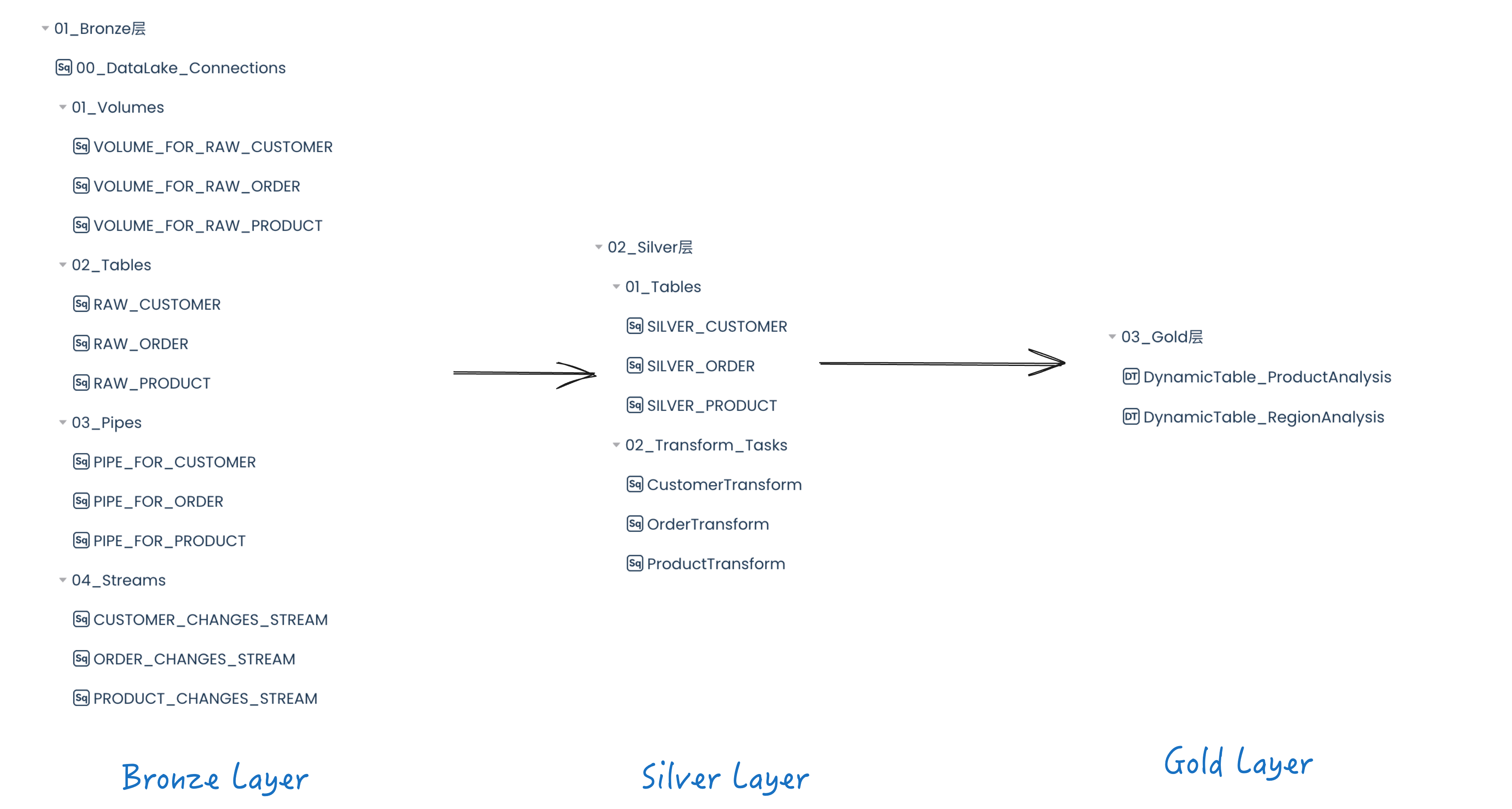
Bronze Layer
The Bronze layer focuses on ingesting data from Alibaba Cloud Object Storage Service (OSS) into Singdata Lakehouse. This is done by creating a data lake Connection and External Volume, as well as Lakehouse Pipe and Table Stream. At this stage, the location of the data in Alibaba Cloud OSS is specified in the External Volume. Using External Volume, data can be automatically ingested into Lakehouse tables in real-time using Lakehouse Pipe.
Finally, create a Table Stream for each table to track and save any changes made to the tables. These streams can be used to identify changes in the Bronze layer tables and update the corresponding tables in the Silver layer.
Silver Layer
The Silver layer focuses on data cleaning and transformation. It uses raw data from the Bronze layer and transforms it to meet the company's needs. These transformations include cleaning missing or anomalous values, data validation, and removing unused or unimportant data.
| Transformation | Details |
|---|
| Email Verification | Ensure emails are not empty |
| Customer Type | Standardize customer types to "Regular", "Premium", or "Unknown" |
| Age Verification | Ensure age is between 18 and 120 |
| Gender Standardization | Classify gender as "Male", "Female", or "Other" |
| Total Purchase Verification | Ensure total purchase is a number, default to 0 if invalid |
| Transformation | Details |
|---|
| Price Validation | Ensure the price is a positive number |
| Inventory Quantity Validation | Ensure the inventory quantity is non-negative |
| Rating Validation | Ensure the rating is between 0 and 5 |
| Transformation | Details |
|---|
| Amount Validation | Ensure the transaction amount is greater than 0 |
| Transaction ID Validation | Ensure the transaction ID is not empty |
Gold Layer
The Gold layer aims to create dynamic tables for business analysis using the transformed data from the Silver layer. For example, DT_RegionAnalysis is a unified data view combining all 3 tables to analyze sales performance in different regions and identify the best-performing regions in terms of sales.
In addition to the simple dynamic tables demonstrated in this project, many additional analyses can be performed in the Gold layer.
Data Flow
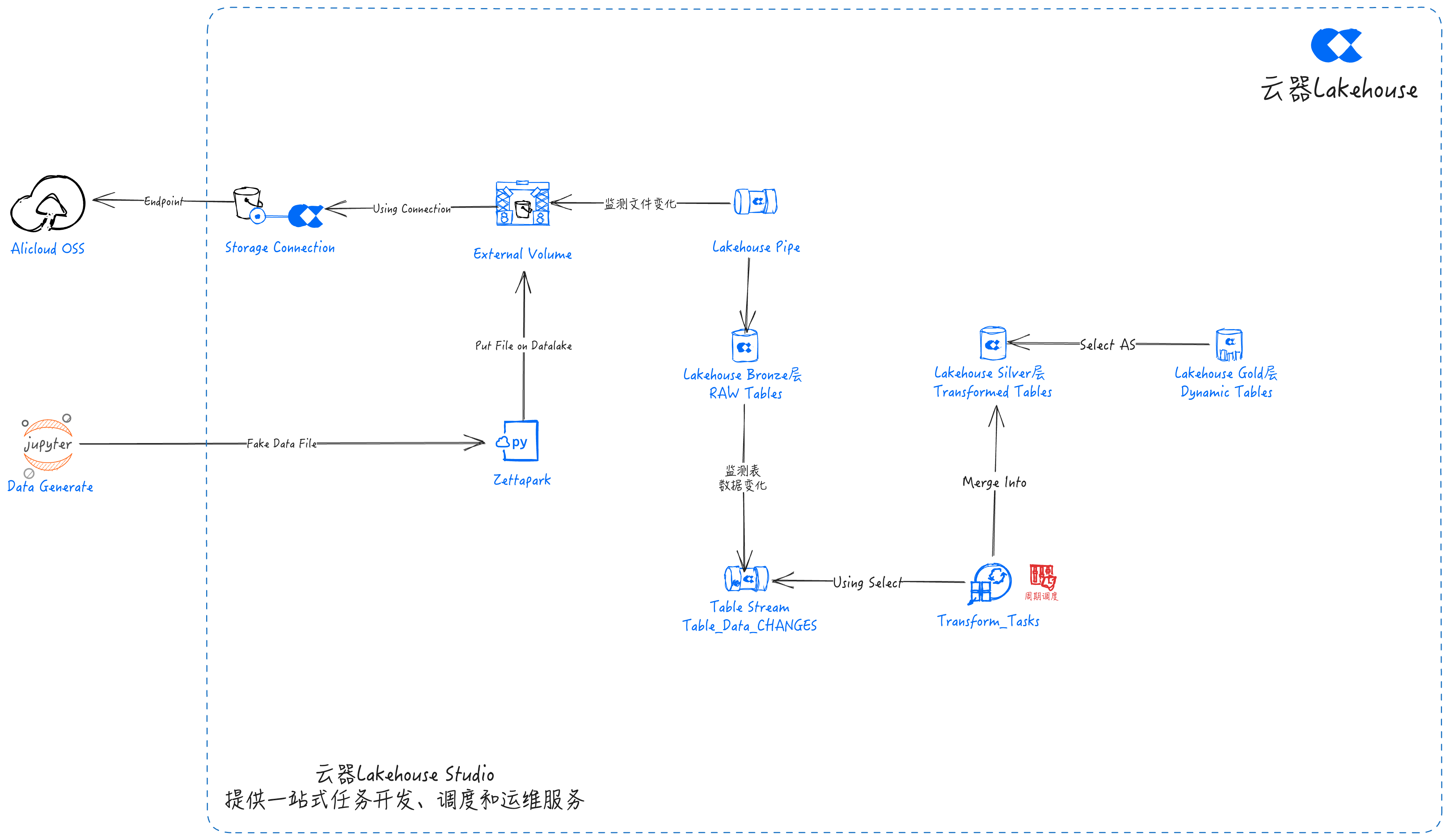
Implementation Steps Based on Singdata Lakehouse
Navigate to Lakehouse Studio Development -> Tasks,
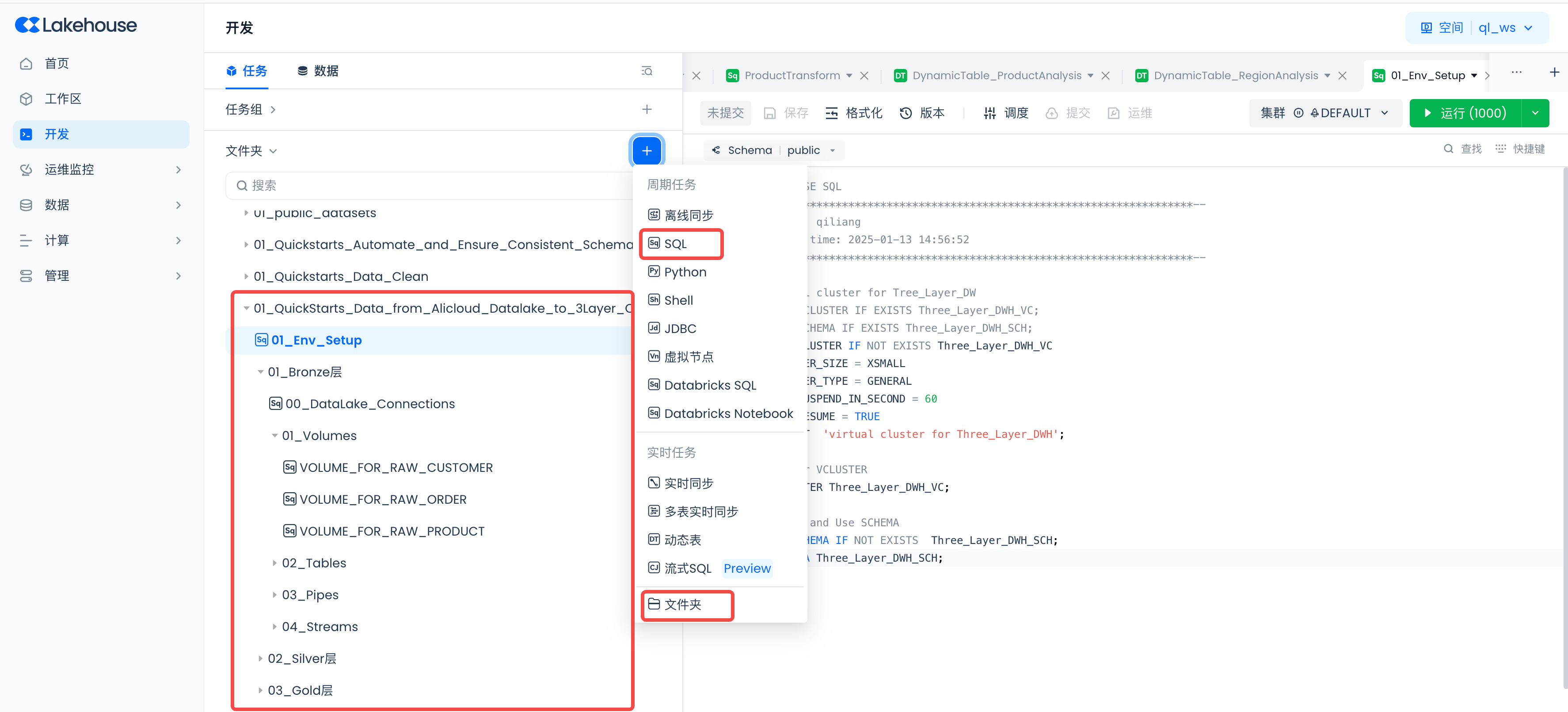
Click “+” to create the following directory:
- 01_QuickStarts_Data_from_Alicloud_Datalake_to_3Layer_Clickzetta_Data_Warehouse
Click “+” to create the following SQL task, and click run after creation:

Building the Lakehouse Environment
Create a new SQL task: 01_Env_Setup
CREATE VCLUSTER IF NOT EXISTS Three_Layer_DWH_VC
VCLUSTER_SIZE = XSMALL
VCLUSTER_TYPE = GENERAL
AUTO_SUSPEND_IN_SECOND = 60
AUTO_RESUME = TRUE
COMMENT 'virtual cluster for Three_Layer_DWH';
-- Use our VCLUSTER
USE VCLUSTER Three_Layer_DWH_VC;
-- Create and Use SCHEMA
CREATE SCHEMA IF NOT EXISTS Three_Layer_DWH_SCH;
USE SCHEMA Three_Layer_DWH_SCH;
Developing the Bronze Layer
Create a new directory: 01_Bronze Layer
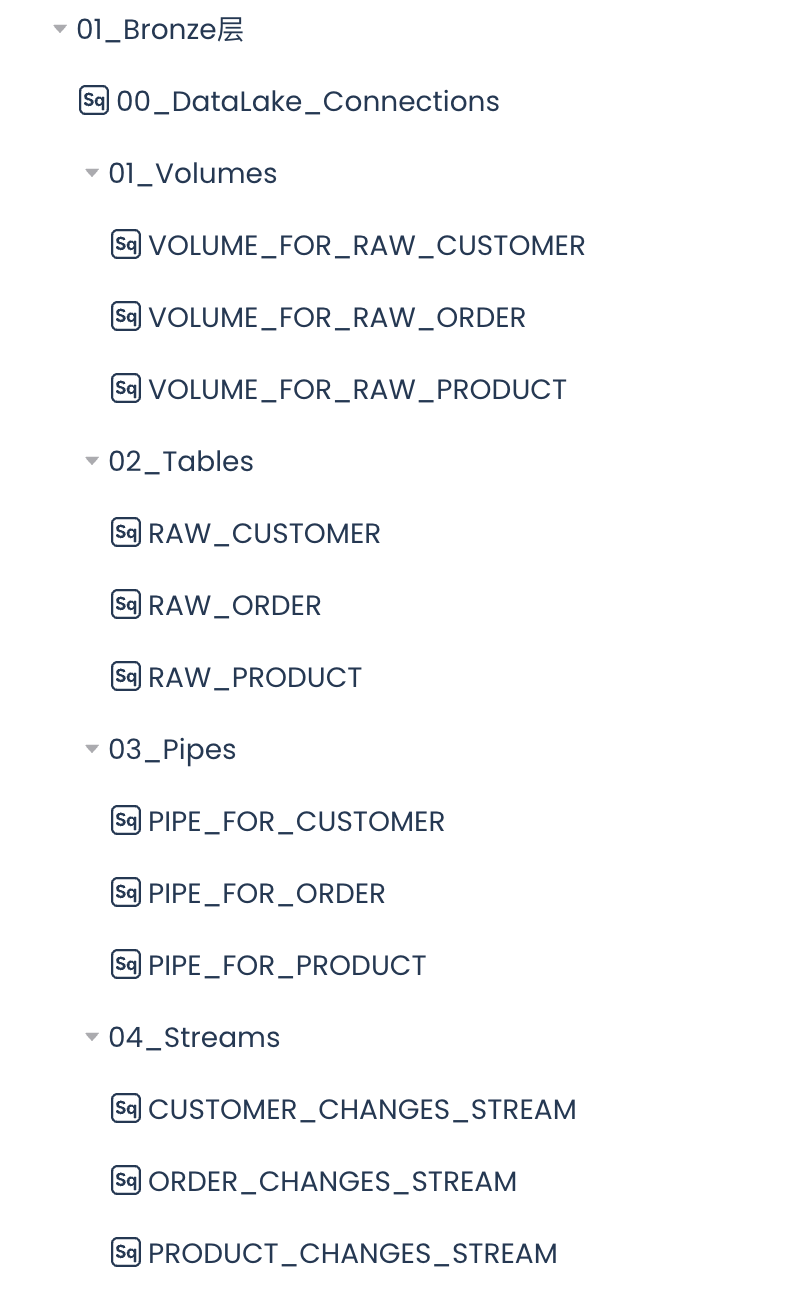
Create Data Lake Connection
Create a new SQL task: 00_DataLake_Connections
-- Use our VCLUSTER and SCHEMA
USE VCLUSTER Three_Layer_DWH_VC;
USE SCHEMA Three_Layer_DWH_SCH;
external data lake
Create data lake Connection, connection to the data lake
CREATE STORAGE CONNECTION if not exists hz_ingestion_demo
TYPE oss
ENDPOINT = 'oss-cn-hangzhou-internal.aliyuncs.com'
access_id = '请输入您的access_id'
access_key = '请输入您的access_key'
comments = 'hangzhou oss private endpoint for ingest demo';
Create Data Lake Volumes
Create data lake Volumes, each Volume corresponds to the storage location of customer, product, and order data files.
Create a new SQL task: VOLUME_FOR_RAW_CUSTOMER
-- Use our VCLUSTER and SCHEMA
USE VCLUSTER Three_Layer_DWH_VC;
USE SCHEMA Three_Layer_DWH_SCH;
-- Create Volume, the location of the data lake storage file
CREATE EXTERNAL VOLUME if not exists VOLUME_FOR_RAW_CUSTOMER
LOCATION 'oss://yourbucketname/VOLUME_FOR_RAW_CUSTOMER'
USING connection hz_ingestion_demo -- storage Connection
DIRECTORY = (
enable = TRUE
)
recursive = TRUE;
-- Synchronize the directory of the data lake Volume to Lakehouse
ALTER volume VOLUME_FOR_RAW_CUSTOMER refresh;
-- View files on the Singdata Lakehouse data lake Volume
SELECT * from directory(volume VOLUME_FOR_RAW_CUSTOMER);
Creating a New SQL Task: VOLUME_FOR_RAW_ORDER
-- Use our VCLUSTER and SCHEMA
USE VCLUSTER Three_Layer_DWH_VC;
USE SCHEMA Three_Layer_DWH_SCH;
-- Create Volume, the location of the data lake storage file
CREATE EXTERNAL VOLUME if not exists VOLUME_FOR_RAW_ORDER
LOCATION 'oss://yourbucketname/VOLUME_FOR_RAW_ORDER'
USING connection hz_ingestion_demo -- storage Connection
DIRECTORY = (
enable = TRUE
)
recursive = TRUE;
-- Synchronize the directory of the data lake Volume to the Lakehouse
ALTER volume VOLUME_FOR_RAW_ORDER refresh;
-- View the files on the Singdata Lakehouse data lake Volume
SELECT * from directory(volume VOLUME_FOR_RAW_ORDER);
Create SQL Task: VOLUME_FOR_RAW_PRODUCT
-- Use our VCLUSTER and SCHEMA
USE VCLUSTER Three_Layer_DWH_VC;
USE SCHEMA Three_Layer_DWH_SCH;
-- Create Volumes, the location of the data lake storage files
CREATE EXTERNAL VOLUME if not exists VOLUME_FOR_RAW_PRODUCT
LOCATION 'oss://yourbucketname/VOLUME_FOR_RAW_PRODUCT'
USING connection hz_ingestion_demo -- storage Connection
DIRECTORY = (
enable = TRUE
)
recursive = TRUE;
-- Synchronize the directory of the data lake Volume to the Lakehouse
ALTER volume VOLUME_FOR_RAW_PRODUCT refresh;
-- View the files on the Singdata Lakehouse data lake Volume
SELECT * from directory(volume VOLUME_FOR_RAW_PRODUCT);
Create Tables
Create Tables, each table will correspond to storing raw data of customers, products, and orders.
Create a new SQL task: RAW_CUSTOMER
-- Use our VCLUSTER and SCHEMA
USE VCLUSTER Three_Layer_DWH_VC;
USE SCHEMA Three_Layer_DWH_SCH;
-- Create the table to store customer data
CREATE TABLE IF NOT EXISTS raw_customer (
customer_id INT,
name STRING,
email STRING,
country STRING,
customer_type STRING,
registration_date STRING,
age INT,
gender STRING,
total_purchases INT,
ingestion_timestamp TIMESTAMP_NTZ DEFAULT CURRENT_TIMESTAMP()
);
Create a New SQL Task: RAW_ORDER
-- Use our VCLUSTER and SCHEMA
USE VCLUSTER Three_Layer_DWH_VC;
USE SCHEMA Three_Layer_DWH_SCH;
-- Create table to store order data
CREATE TABLE IF NOT EXISTS raw_order (
customer_id INT,
payment_method STRING,
product_id INT,
quantity INT,
store_type STRING,
total_amount DOUBLE,
transaction_date DATE,
transaction_id STRING,
ingestion_timestamp TIMESTAMP_NTZ DEFAULT CURRENT_TIMESTAMP()
);
Create SQL Task: RAW_PRODUCT
-- Use our VCLUSTER and SCHEMA
USE VCLUSTER Three_Layer_DWH_VC;
USE SCHEMA Three_Layer_DWH_SCH;
-- Create the table to store the the product data
CREATE TABLE IF NOT EXISTS raw_product (
product_id INT,
name STRING,
category STRING,
brand STRING,
price FLOAT,
stock_quantity INT,
rating FLOAT,
is_active BOOLEAN,
ingestion_timestamp TIMESTAMP_NTZ DEFAULT CURRENT_TIMESTAMP()
);
Create Pipes
Create Pipes, each Pipe will correspond to the data in the customer, product, and order files, ingesting it in real-time into the raw tables of the Singdata Lakehouse.
Create a new SQL task: PIPE_FOR_CUSTOMER
-- Use our VCLUSTER and SCHEMA
USE VCLUSTER Three_Layer_DWH_VC;
USE SCHEMA Three_Layer_DWH_SCH;
CREATE PIPE IF NOT EXISTS PIPE_FOR_CUSTOMER
VIRTUAL_CLUSTER = 'Three_Layer_DWH_VC'
-- Execute to get the latest file using scan file mode
INGEST_MODE = 'LIST_PURGE'
AS
COPY INTO raw_customer FROM VOLUME VOLUME_FOR_RAW_CUSTOMER (
customer_id INT,
name STRING,
email STRING,
country STRING,
customer_type STRING,
registration_date STRING,
age INT,
gender STRING,
total_purchases INT,
ingestion_timestamp TIMESTAMP_NTZ
)
USING CSV OPTIONS (
'header'='true'
)
-- Must add purge parameter to delete data after successful import
PURGE=true
;
Create SQL Task: PIPE_FOR_ORDER
-- Use our VCLUSTER and SCHEMA
USE VCLUSTER Three_Layer_DWH_VC;
USE SCHEMA Three_Layer_DWH_SCH;
CREATE PIPE IF NOT EXISTS PIPE_FOR_ORDER
VIRTUAL_CLUSTER = 'Three_Layer_DWH_VC'
-- Execute to get the latest file using scan file mode
INGEST_MODE = 'LIST_PURGE'
AS
COPY INTO raw_ORDER FROM VOLUME VOLUME_FOR_RAW_ORDER (
customer_id INT,
payment_method STRING,
product_id INT,
quantity INT,
store_type STRING,
total_amount DOUBLE,
transaction_date DATE,
transaction_id STRING,
ingestion_timestamp TIMESTAMP_NTZ
)
USING CSV OPTIONS (
'header'='true'
)
-- Must add purge parameter to delete data after successful import
PURGE=true
;
Create SQL Task: PIPE_FOR_PRODUCT
-- Use our VCLUSTER and SCHEMA
USE VCLUSTER Three_Layer_DWH_VC;
USE SCHEMA Three_Layer_DWH_SCH;
CREATE PIPE IF NOT EXISTS PIPE_FOR_PRODUCT
VIRTUAL_CLUSTER = 'Three_Layer_DWH_VC'
-- Execute to get the latest file using scan file mode
INGEST_MODE = 'LIST_PURGE'
AS
COPY INTO raw_PRODUCT FROM VOLUME VOLUME_FOR_RAW_PRODUCT (
product_id INT,
name STRING,
category STRING,
brand STRING,
price FLOAT,
stock_quantity INT,
rating FLOAT,
is_active BOOLEAN,
ingestion_timestamp TIMESTAMP_NTZ
)
USING CSV OPTIONS (
'header'='true'
)
-- Must add purge parameter to delete data after successful import
PURGE=true
;
Create Table Streams
Create Table Streams, each Stream will detect data changes in the original table and store the changed data into the Table Stream.
Create a new SQL task: CUSTOMER_CHANGES_STREAM
-- Use our VCLUSTER and SCHEMA
USE VCLUSTER Three_Layer_DWH_VC;
USE SCHEMA Three_Layer_DWH_SCH;
CREATE TABLE STREAM IF NOT EXISTS customer_changes_stream
ON TABLE raw_customer
WITH PROPERTIES ('TABLE_STREAM_MODE' = 'APPEND_ONLY');
Create SQL Task: ORDER_CHANGES_STREAM
-- Use our VCLUSTER and SCHEMA
USE VCLUSTER Three_Layer_DWH_VC;
USE SCHEMA Three_Layer_DWH_SCH;
CREATE TABLE STREAM IF NOT EXISTS order_changes_stream
ON TABLE raw_order
WITH PROPERTIES ('TABLE_STREAM_MODE' = 'APPEND_ONLY');
Create SQL Task: PRODUCT_CHANGES_STREAM
-- Use our VCLUSTER and SCHEMA
USE VCLUSTER Three_Layer_DWH_VC;
USE SCHEMA Three_Layer_DWH_SCH;
CREATE TABLE STREAM IF NOT EXISTS product_changes_stream
ON TABLE raw_product
WITH PROPERTIES ('TABLE_STREAM_MODE' = 'APPEND_ONLY');
Developing the Silver Layer
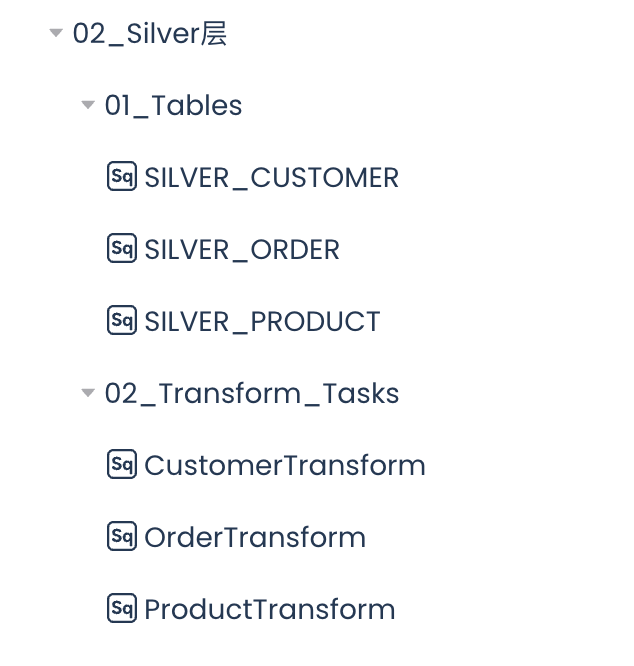
Creating Tables
Create the tables for the Silver layer to store the cleaned and transformed data.
Create a new SQL task: SILVER_CUSTOMER
-- Use our VCLUSTER and SCHEMA
USE VCLUSTER Three_Layer_DWH_VC;
USE SCHEMA Three_Layer_DWH_SCH;
-- Silver Customer Table
CREATE TABLE IF NOT EXISTS SILVER_CUSTOMER (
customer_id INT,
name STRING,
email STRING,
country STRING,
customer_type STRING,
registration_date DATE,
age INT,
gender STRING,
total_purchases INT,
last_updated_timestamp TIMESTAMP_NTZ DEFAULT CURRENT_TIMESTAMP()
);
Create SQL Task: SILVER_ORDERS
-- Use our VCLUSTER and SCHEMA
USE VCLUSTER Three_Layer_DWH_VC;
USE SCHEMA Three_Layer_DWH_SCH;
-- Silver Order Table
CREATE TABLE IF NOT EXISTS SILVER_ORDERS (
transaction_id STRING,
customer_id INT,
product_id INT,
quantity INT,
store_type STRING,
total_amount DOUBLE,
transaction_date DATE,
payment_method STRING,
last_updated_timestamp TIMESTAMP_NTZ DEFAULT CURRENT_TIMESTAMP()
);
Create a new SQL task: SILVER_PRODUCT
-- Use our VCLUSTER and SCHEMA
USE VCLUSTER Three_Layer_DWH_VC;
USE SCHEMA Three_Layer_DWH_SCH;
-- Silver Product Table
CREATE TABLE IF NOT EXISTS SILVER_PRODUCT (
product_id INT,
name STRING,
category STRING,
brand STRING,
price FLOAT,
stock_quantity INT,
rating FLOAT,
is_active BOOLEAN,
last_updated_timestamp TIMESTAMP_NTZ DEFAULT CURRENT_TIMESTAMP()
);
Develop SQL tasks to clean and transform raw data.
Create a new SQL task: CustomerTransform
-- Use our VCLUSTER and SCHEMA
USE VCLUSTER Three_Layer_DWH_VC;
USE SCHEMA Three_Layer_DWH_SCH;
-- Merge changes into silver layer
MERGE INTO silver_customer AS target
USING (
SELECT
customer_id,
name,
email,
country,
-- Customer type standardization
CASE
WHEN TRIM(UPPER(customer_type)) IN ('REGULAR', 'REG', 'R') THEN 'Regular'
WHEN TRIM(UPPER(customer_type)) IN ('PREMIUM', 'PREM', 'P') THEN 'Premium'
ELSE 'Unknown'
END AS customer_type,
-- Convert registration_date to DATE type for compatibility
CAST(registration_date AS DATE) AS registration_date,
-- Age validation
CASE
WHEN age BETWEEN 18 AND 120 THEN age
ELSE NULL
END AS age,
-- Gender standardization
CASE
WHEN TRIM(UPPER(gender)) IN ('M', 'MALE') THEN 'Male'
WHEN TRIM(UPPER(gender)) IN ('F', 'FEMALE') THEN 'Female'
ELSE 'Other'
END AS gender,
-- Total purchases validation
CASE
WHEN total_purchases >= 0 THEN total_purchases
ELSE 0
END AS total_purchases,
current_timestamp() AS last_updated_timestamp
FROM customer_changes_stream
WHERE customer_id IS NOT NULL AND email IS NOT NULL -- Basic data quality rule
) AS source
ON target.customer_id = source.customer_id
WHEN MATCHED THEN
UPDATE SET
name = source.name,
email = source.email,
country = source.country,
customer_type = source.customer_type,
registration_date = source.registration_date,
age = source.age,
gender = source.gender,
total_purchases = source.total_purchases,
last_updated_timestamp = source.last_updated_timestamp
WHEN NOT MATCHED THEN
INSERT (customer_id, name, email, country, customer_type, registration_date, age, gender, total_purchases, last_updated_timestamp)
VALUES (source.customer_id, source.name, source.email, source.country, source.customer_type, source.registration_date, source.age, source.gender, source.total_purchases, source.last_updated_timestamp);
Creating a New SQL Task: VOLUME_FOR_RAW_ORDER
-- Use our VCLUSTER and SCHEMA
USE VCLUSTER Three_Layer_DWH_VC;
USE SCHEMA Three_Layer_DWH_SCH;
MERGE INTO silver_orders AS target
USING (
SELECT
transaction_id,
customer_id,
product_id,
quantity,
store_type,
total_amount,
transaction_date,
payment_method,
CURRENT_TIMESTAMP() AS last_updated_timestamp
FROM order_changes_stream where transaction_id is not null
and total_amount> 0) AS source
ON target.transaction_id = source.transaction_id
WHEN MATCHED THEN
UPDATE SET
customer_id = source.customer_id,
product_id = source.product_id,
quantity = source.quantity,
store_type = source.store_type,
total_amount = source.total_amount,
transaction_date = source.transaction_date,
payment_method = source.payment_method,
last_updated_timestamp = source.last_updated_timestamp
WHEN NOT MATCHED THEN
INSERT (transaction_id, customer_id, product_id, quantity, store_type, total_amount, transaction_date, payment_method, last_updated_timestamp)
VALUES (source.transaction_id, source.customer_id, source.product_id, source.quantity, source.store_type, source.total_amount, source.transaction_date, source.payment_method, source.last_updated_timestamp);
Create SQL Task: VOLUME_FOR_RAW_PRODUCT
-- Use our VCLUSTER and SCHEMA
USE VCLUSTER Three_Layer_DWH_VC;
USE SCHEMA Three_Layer_DWH_SCH;
MERGE INTO silver_product AS target
USING (
SELECT
product_id,
name AS name,
category,
-- Price validation and normalization
CASE
WHEN price < 0 THEN 0
ELSE price
END AS price,
brand,
-- Stock quantity validation
CASE
WHEN stock_quantity >= 0 THEN stock_quantity
ELSE 0
END AS stock_quantity,
-- Rating validation
CASE
WHEN rating BETWEEN 0 AND 5 THEN rating
ELSE 0
END AS rating,
is_active,
CURRENT_TIMESTAMP() AS last_updated_timestamp
FROM product_changes_stream
) AS source
ON target.product_id = source.product_id
WHEN MATCHED THEN
UPDATE SET
name = source.name,
category = source.category,
price = source.price,
brand = source.brand,
stock_quantity = source.stock_quantity,
rating = source.rating,
is_active = source.is_active,
last_updated_timestamp = source.last_updated_timestamp
WHEN NOT MATCHED THEN
INSERT (product_id, name, category, price, brand, stock_quantity, rating, is_active, last_updated_timestamp)
VALUES (source.product_id, source.name, source.category, source.price, source.brand, source.stock_quantity, source.rating, source.is_active, source.last_updated_timestamp);
Developing the Gold Layer

Developing Dynamic Tables
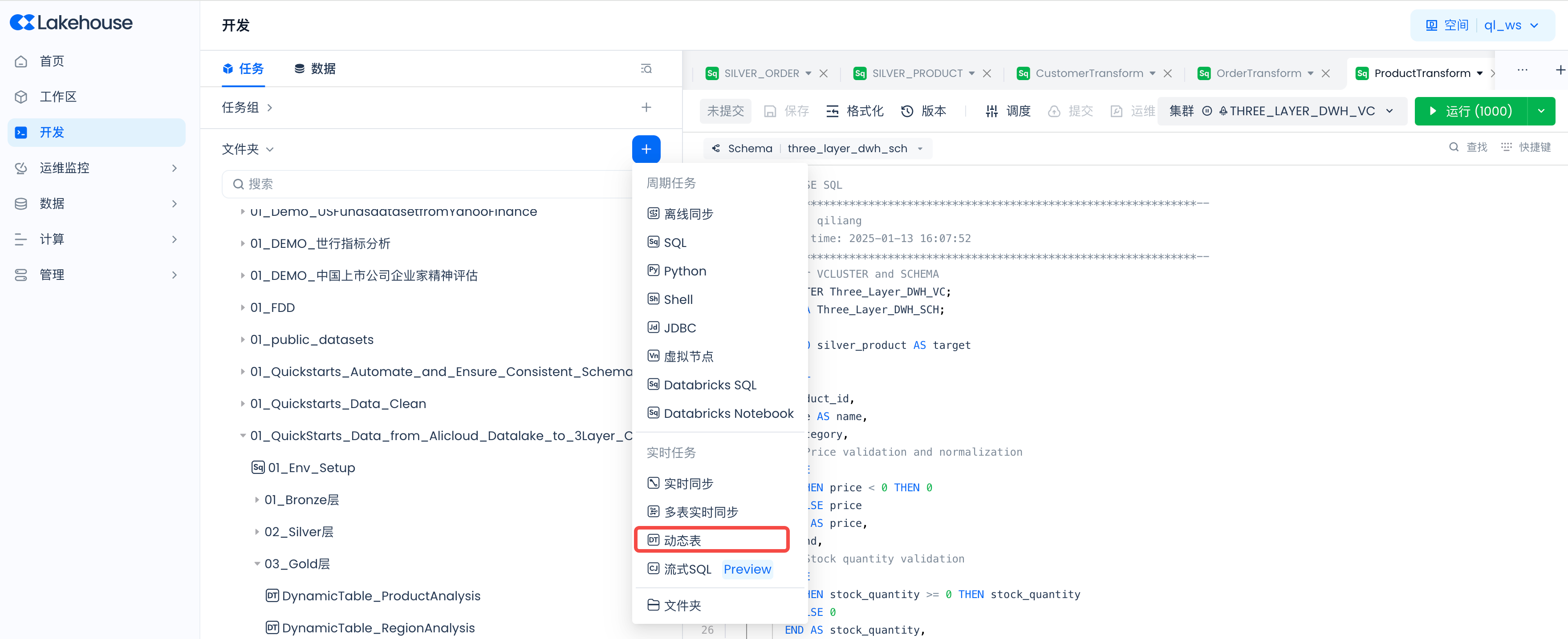
Develop dynamic tables to perform business analysis on the data.
Create a new dynamic table: DynamicTable_ProductAnalysis
SELECT
p.CATEGORY,
c.GENDER,
SUM(o.TOTAL_AMOUNT) AS TOTAL_SALES,
AVG(p.RATING) AS AVG_RATING
FROM SILVER_ORDERS AS o
JOIN SILVER_PRODUCT AS p
ON o.product_id = p.product_id
JOIN SILVER_CUSTOMER AS c
ON o.customer_id = c.customer_id
GROUP BY
P.CATEGORY,
C.GENDER
ORDER BY
c.GENDER,
TOTAL_SALES DESC;
Create a Dynamic Table: DynamicTable_RegionAnalysis
SELECT
CASE
WHEN c.COUNTRY IN ('USA', 'Canada') THEN 'NA'
WHEN c.COUNTRY IN ('Brazil') THEN 'SA'
WHEN c.COUNTRY IN ('Australia') THEN 'AUS'
WHEN c.COUNTRY IN ('Germany', 'UK', 'France') THEN 'EU'
WHEN c.COUNTRY IN ('China', 'India', 'Japan') THEN 'ASIA'
ELSE 'UNKNOWN'
END AS REGION,
o.STORE_TYPE,
SUM(o.TOTAL_AMOUNT) AS TOTAL_SALES,
AVG(o.TOTAL_AMOUNT) AS AVG_SALE,
AVG(o.QUANTITY) AS AVG_QUANTITY
FROM SILVER_ORDERS AS o
JOIN SILVER_PRODUCT AS p
ON o.product_id = p.product_id
JOIN SILVER_CUSTOMER AS c
ON o.customer_id = c.customer_id
GROUP BY
REGION,
o.STORE_TYPE
ORDER BY
TOTAL_SALES DESC,
AVG_SALE DESC,
AVG_QUANTITY DESC;
Follow the steps below to schedule the three data transformation tasks of the Silver layer to run every minute.
Set scheduling parameters:
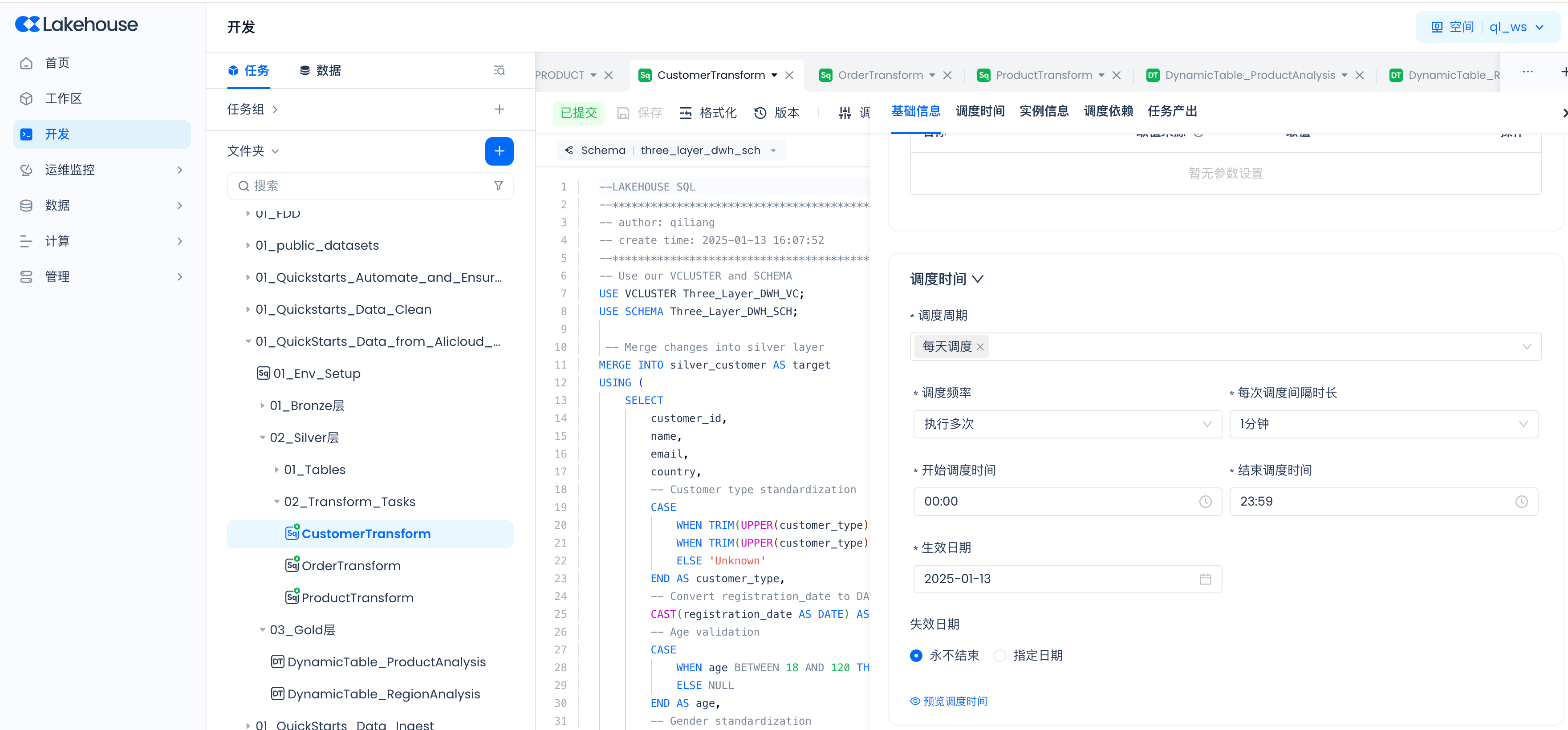
Then submit:
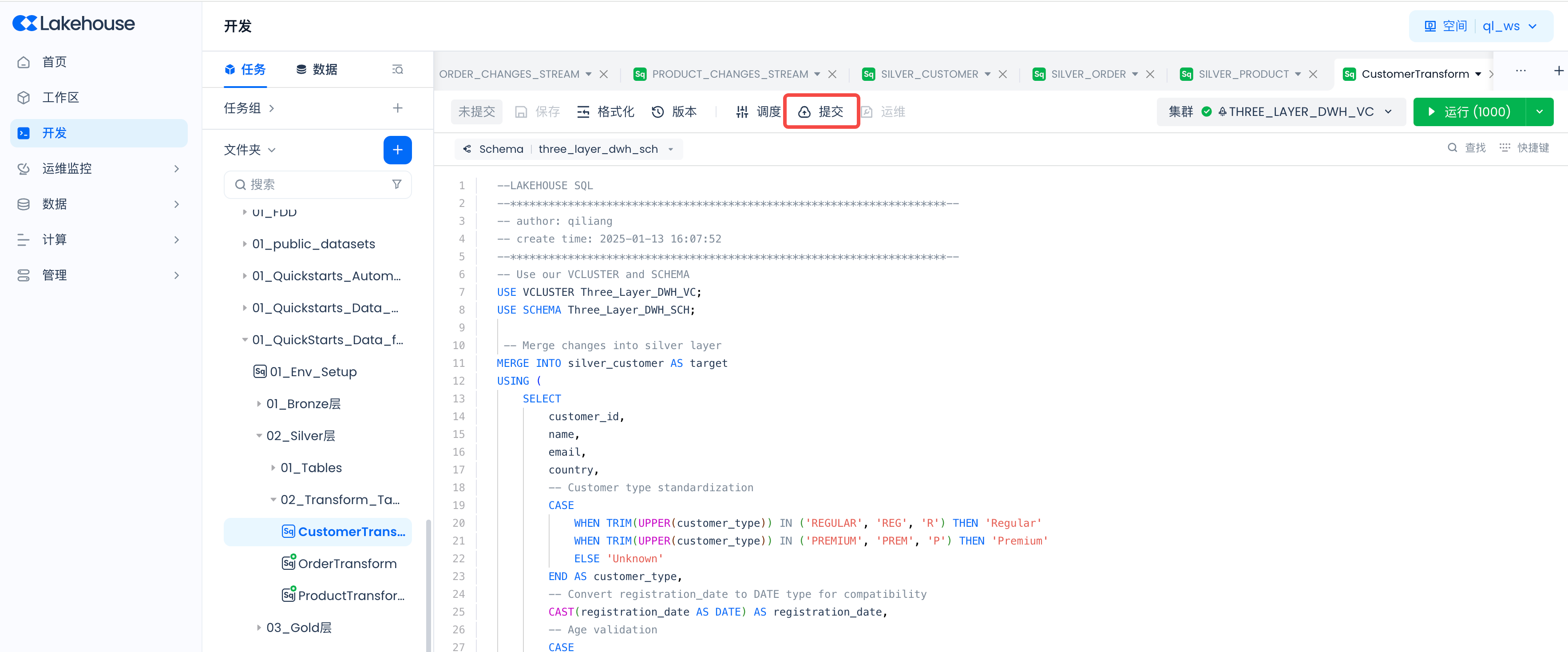
Ensure to repeat the above steps to set up and start scheduling for all three data transformation tasks.
You can set the scheduling period to 1 minute, so you can see the data in the Silver layer tables in about 1 minute.
Start Gold Layer Dynamic Table Auto Refresh
Follow the steps below to start the dynamic table.
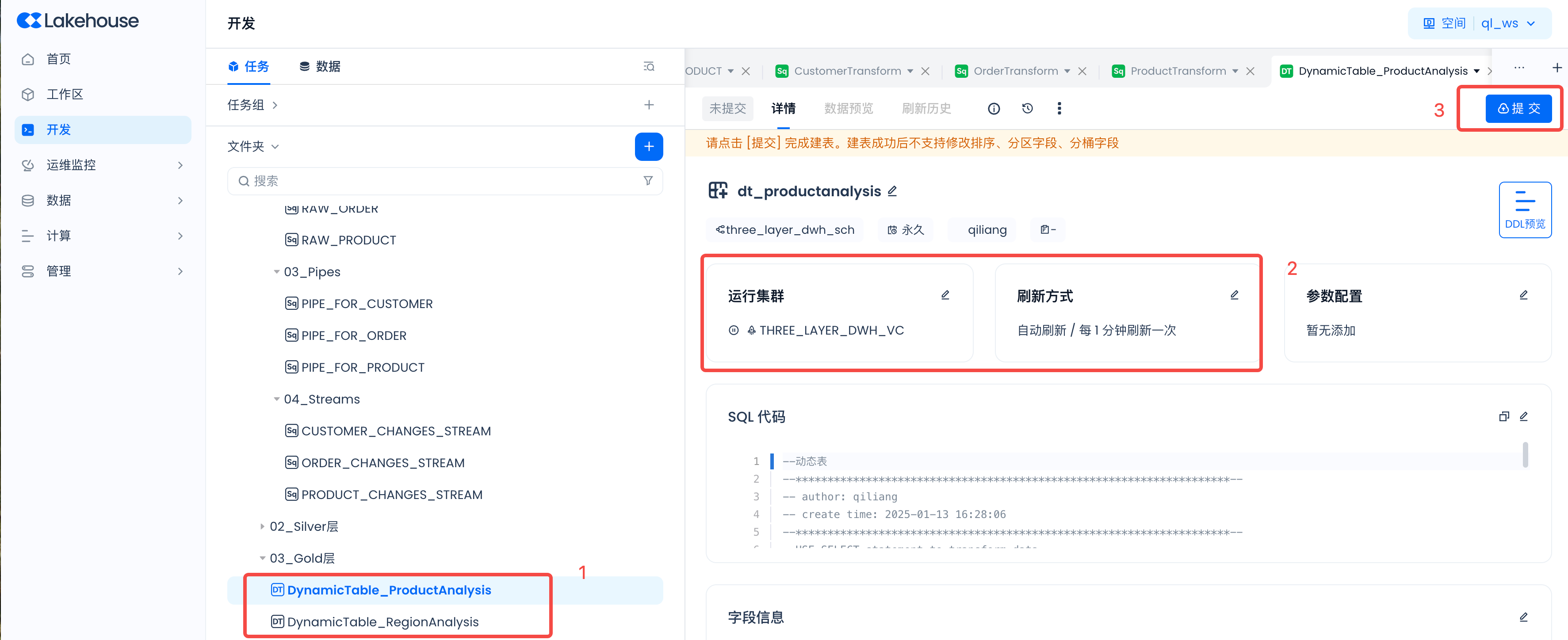
Set the running cluster to "Three_Layer_DWH_VC", set the refresh mode to "Auto Refresh", and set the refresh interval to "1 minute". Then submit.
Check Object Creation Results
Navigate to Development -> Tasks, and create a new SQL task "09_Test Verification"
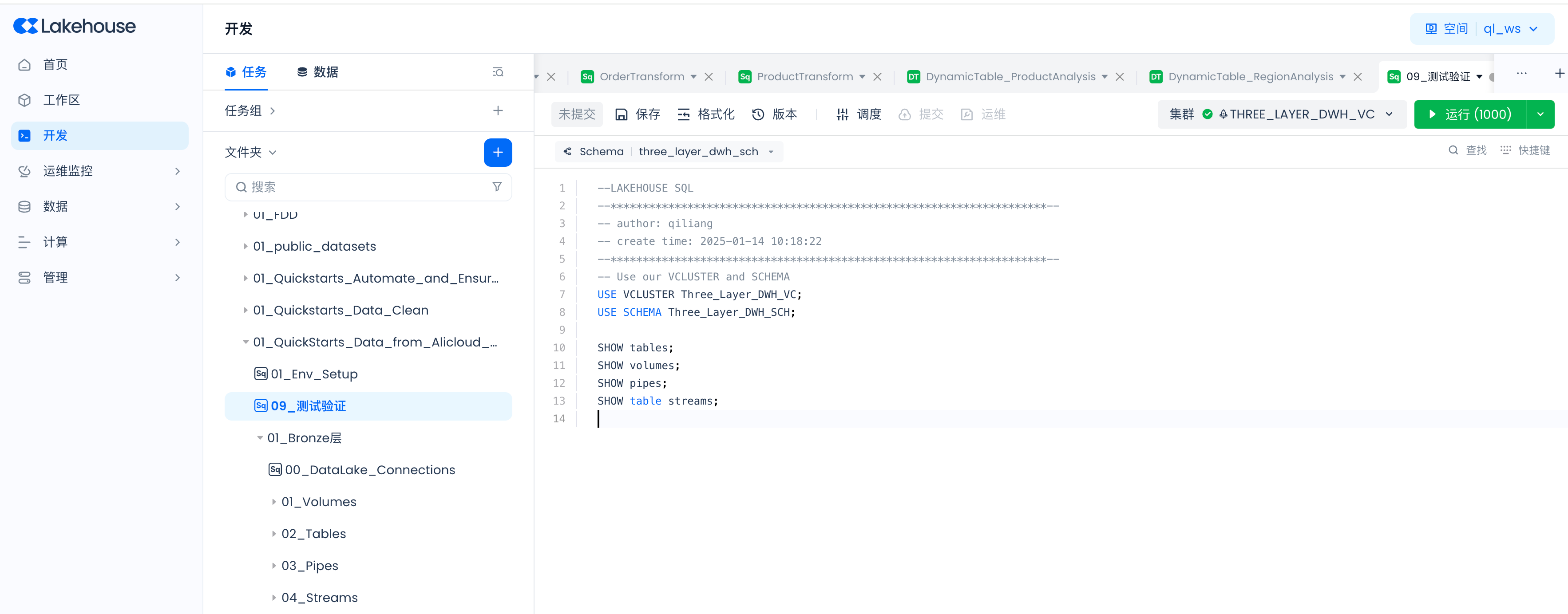
SHOW tables;
SHOW volumes;
SHOW pipes;
SHOW table streams;
SHOW tables results are as follows:
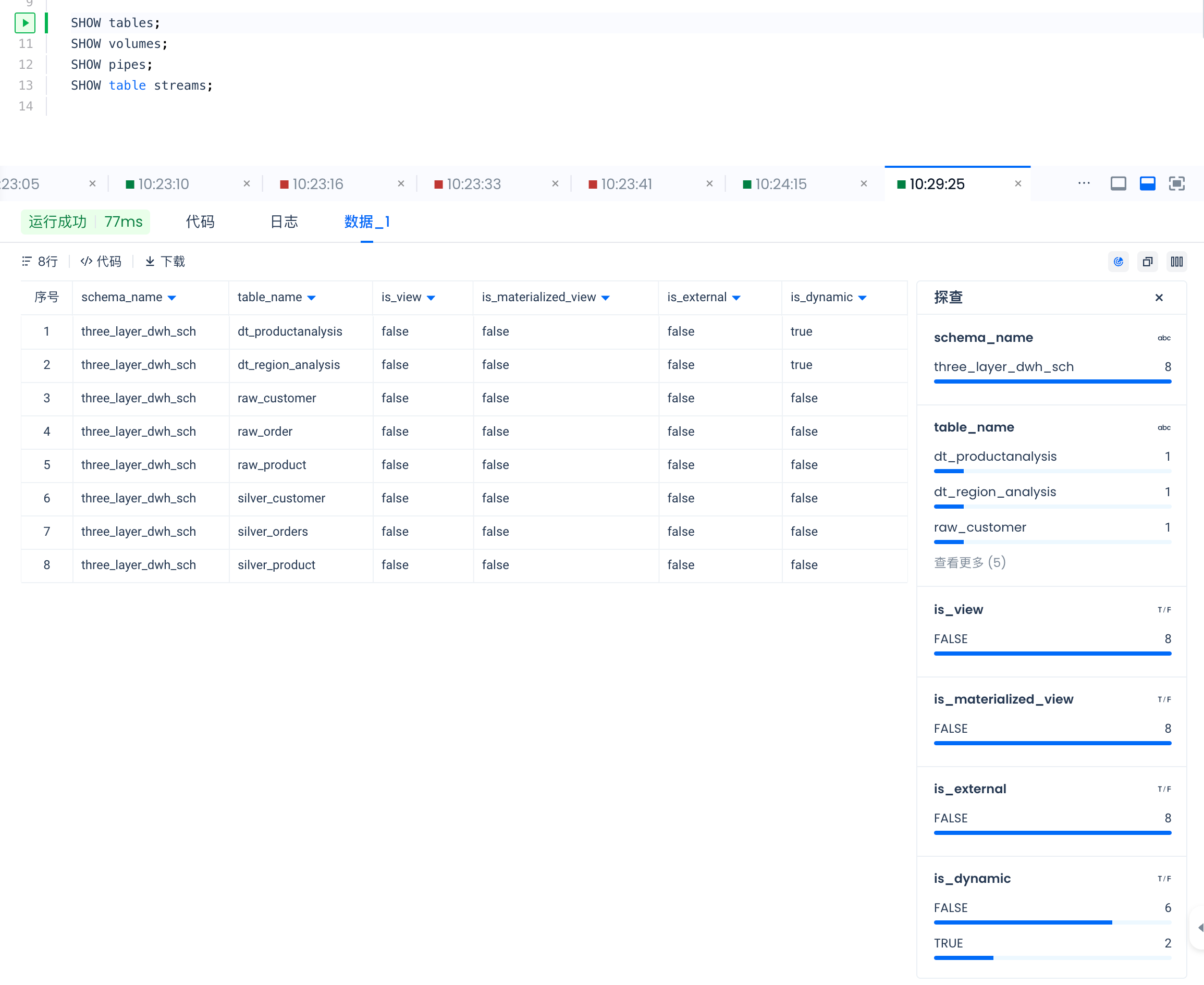
SHOW volumes results are as follows:
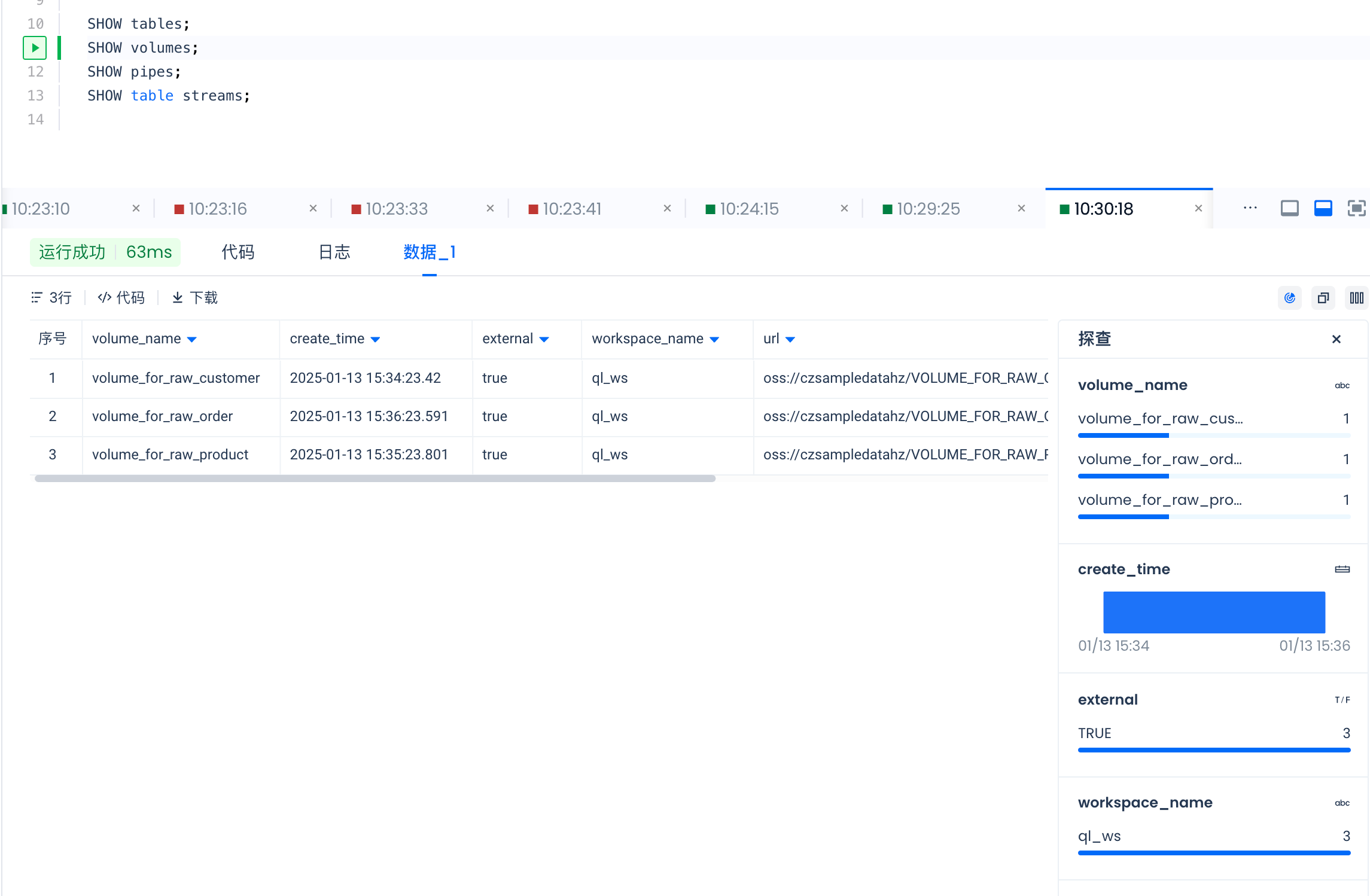
SHOW pipes results are as follows:
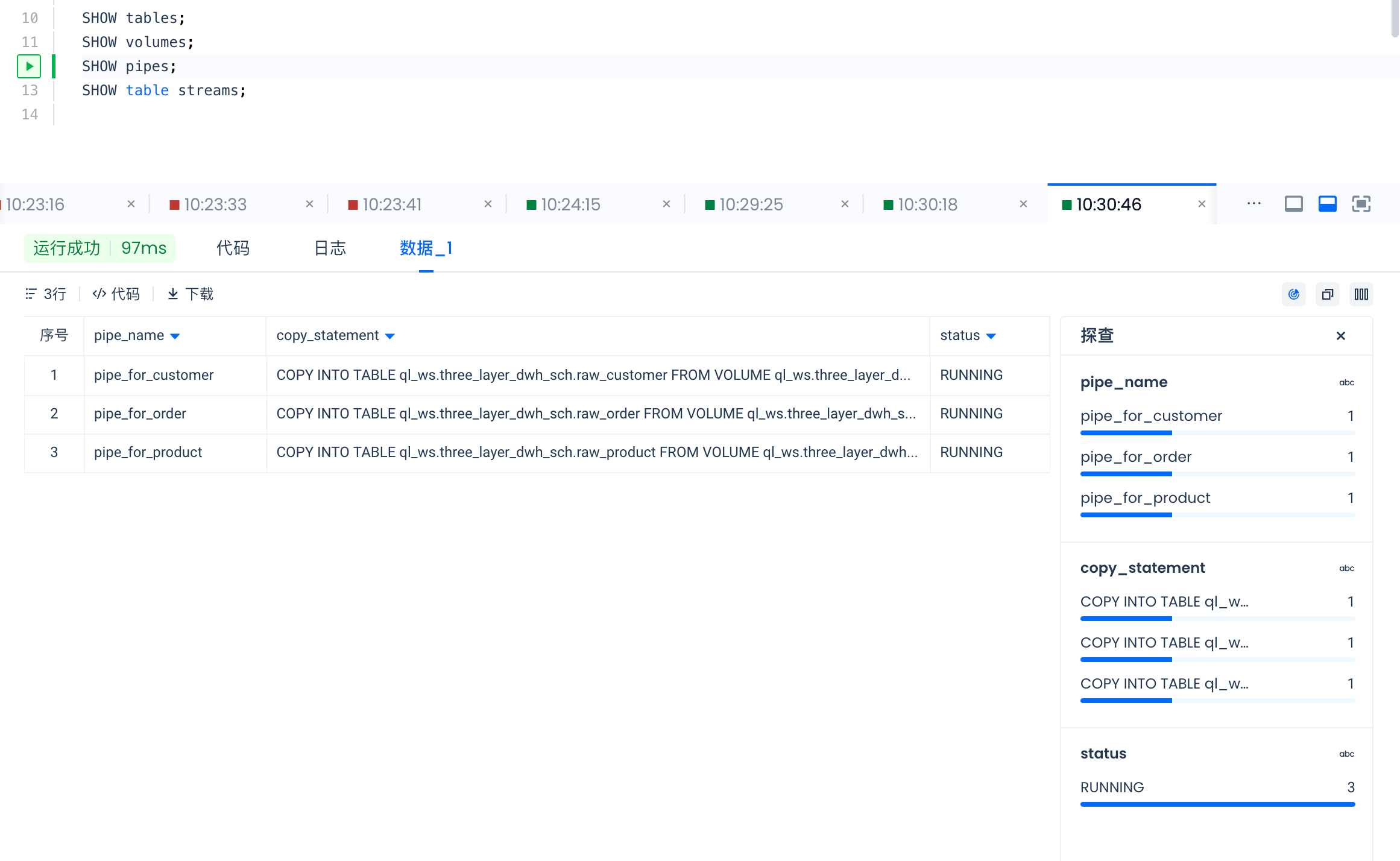
SHOW table streams results are as follows:
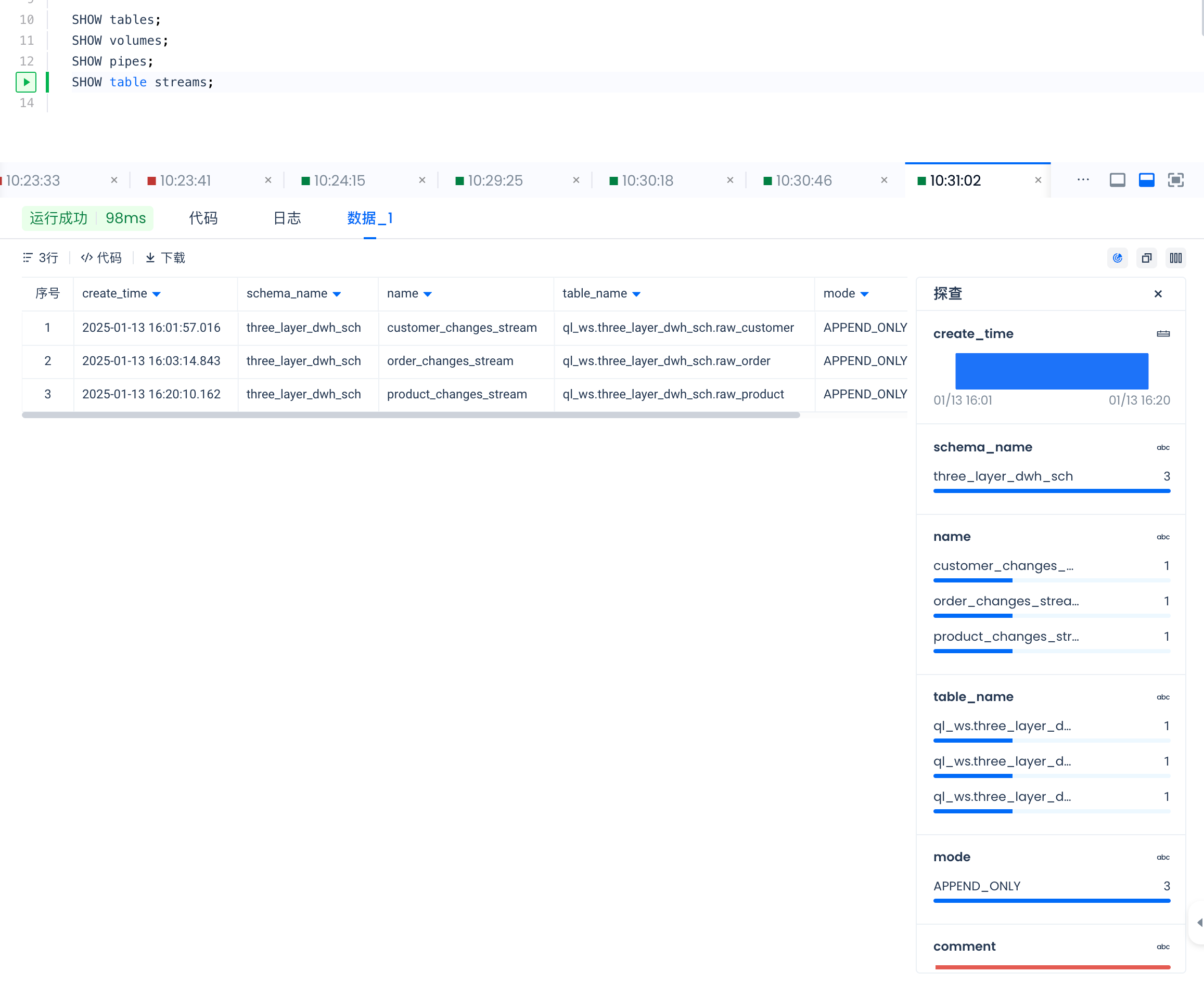
Use the following command to view detailed information of each object:
DESC TABLE EXTENDED raw_customer;
DESC VOLUME volume_for_raw_customer;
DESC PIPE pipe_for_customer;
DESC TABLE STREAM customer_changes_stream;
DESC TABLE EXTENDED dt_productanalysis;
Generate Test Data and PUT to Data Lake
from faker import Faker
import csv
import uuid
import random
from decimal import Decimal
from datetime import datetime
from clickzetta.zettapark.session import Session
import json
fake = Faker()
file_path = f'FakeDataset'
# Function to create a csv file, generating corresponding content based on different tables
def create_csv_file(file_path, table_name, record_count):
with open(file_path, 'w', newline='') as csvfile:
if table_name == "raw_customer":
fieldnames = ["customer_id", "name", "email", "country", "customer_type",
"registration_date", "age", "gender", "total_purchases", "ingestion_timestamp"]
writer = csv.DictWriter(csvfile, fieldnames=fieldnames)
writer.writeheader()
for i in range(1, record_count + 1):
writer.writerow(
{
"customer_id": i,
"name": fake.name(),
"email": fake.email(),
"country": fake.country(),
"customer_type": fake.random_element(elements=("Regular", "Premium", "VIP")),
"registration_date": fake.date(),
"age": fake.random_int(min=18, max=120),
"gender": fake.random_element(elements=("Male", "Female", "Other")),
"total_purchases": fake.random_int(min=0, max=1000),
"ingestion_timestamp": fake.date_time_this_year().isoformat()
}
)
elif table_name == "raw_product":
fieldnames = ["product_id", "name", "category", "brand", "price",
"stock_quantity", "rating", "is_active", "ingestion_timestamp"]
writer = csv.DictWriter(csvfile, fieldnames=fieldnames)
writer.writeheader()
for i in range(1, record_count + 1):
writer.writerow(
{
"product_id": i,
"name": fake.word(),
"category": fake.word(),
"brand": fake.company(),
"price": round(fake.random_number(digits=5, fix_len=False), 2),
"stock_quantity": fake.random_int(min=0, max=1000),
"rating": round(fake.random_number(digits=2, fix_len=True) / 10, 1),
"is_active": fake.boolean(),
"ingestion_timestamp": fake.date_time_this_year().isoformat()
}
)
elif table_name == "raw_order":
fieldnames = ["customer_id", "payment_method", "product_id", "quantity",
"store_type", "total_amount", "transaction_date",
"transaction_id", "ingestion_timestamp"]
writer = csv.DictWriter(csvfile, fieldnames=fieldnames)
writer.writeheader()
for _ in range(record_count):
writer.writerow(
{
"customer_id": fake.random_int(min=1, max=100),
"payment_method": fake.random_element(elements=("Credit Card", "PayPal", "Bank Transfer")),
"product_id": fake.random_int(min=1, max=100),
"quantity": fake.random_int(min=1, max=10),
"store_type": fake.random_element(elements=("Online", "Physical")),
"total_amount": round(fake.random_number(digits=5, fix_len=False), 2),
"transaction_date": fake.date(),
"transaction_id": str(uuid.uuid4()),
"ingestion_timestamp": fake.date_time_this_year().isoformat()
}
)
def put_file_into_volume(filename,volumename):
# Read parameters from the configuration file
with open('security/config-uat-3layer-dwh.json', 'r') as config_file:
config = json.load(config_file)
# Create a session
session = Session.builder.configs(config).create()
session.file.put(filename,f"volume://{volumename}/")
session.sql(f"show volume directory {volumename}").show()
session.close()
# First call:
current_time = datetime.now().strftime("%Y%m%d%H%M%S")
print(current_time)
if __name__ == '__main__':
# Sample call
create_csv_file(f"{file_path}/customer/raw_customer_{current_time}.csv", "raw_customer", 100)
put_file_into_volume(f"{file_path}/customer/raw_customer_{current_time}.csv","VOLUME_FOR_RAW_CUSTOMER")
create_csv_file(f"{file_path}/product/raw_product_{current_time}.csv", "raw_product", 100)
put_file_into_volume(f"{file_path}/product/raw_product_{current_time}.csv","VOLUME_FOR_RAW_PRODUCT")
create_csv_file(f"{file_path}/order/raw_order_{current_time}.csv", "raw_order", 10000)
put_file_into_volume(f"{file_path}/order/raw_order_{current_time}.csv","VOLUME_FOR_RAW_ORDER")
# Second call: only generate order data
current_time = datetime.now().strftime("%Y%m%d%H%M%S")
print(current_time)
if __name__ == '__main__':
create_csv_file(f"{file_path}/order/raw_order_{current_time}.csv", "raw_order", 100000)
put_file_into_volume(f"{file_path}/order/raw_order_{current_time}.csv","VOLUME_FOR_RAW_ORDER")
The first call generates data for products, customers, and orders. For the second and subsequent calls, only new order data needs to be generated. Multiple order files can be uploaded multiple times.
Note that each file PUT to the Volume will be automatically deleted after being consumed by the Pipe.
Documentation
Connection
External Volume
Pipe
Table Stream
Merge Into
Dynamic Table
















